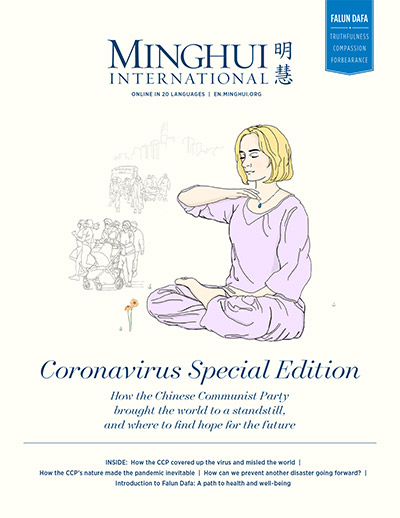(Minghui.org) Chinese is one of the few logographic languages that are still in use today, with characters that are often stylized pictures of the things they represent. While this makes the language difficult to pick up for new learners, this trait gives Chinese one of its unique features: that one can learn to read the language without necessarily knowing how to speak it. It is also one of the few languages that can be written both from left to right and right to left.
But perhaps the most interesting thing about Chinese is the creation of its characters, which, in addition to being tools that people can use to communicate with each other, are also believed to carry divine messages for humanity in their form and origin. Indeed, within the Chinese legend of creation, language is viewed as a gift that links humanity to nature—and most importantly, back to its Creator.
In this article, we take a closer look at the mythology surrounding the Chinese language and the Chinese concept of language, along with the inspiration that it gives us for how to live our lives today.
Part I: Origins of the Universe
Before we can convey the story of the Chinese language’s creation, we need to understand how Chinese culture views the creation of the universe. Like many other legends of creation, the story begins with a Creator.
In the beginning, the Creator called into being the cosmos, the vault of heaven, and all times and places. He circumscribed the Three Realms and placed the Earth within. He breathed life into the sentient beings that inhabited all of creation—from gods, to humans, to objects—and has carefully watched over humanity ever since, nurturing and protecting humans as they gradually blossomed.
The Chinese universe has four phases: birth, maturity, degeneration, and destruction. On the eve of the destruction phase, the Creator has planned to rectify the universe and save the beings within, averting the disintegration of all existence. This is an act of salvation derived from His boundless compassion, and an act that all beings, including humans, should repay with unending gratitude.
The Three Realms forged by the Creator is perceived by humanity in a variety of different ways: the celestial ribbon of the Milky Way, the numerous twinkling stars, the sun, the moon, the Earth with its mountains, rivers, lakes, and oceans, the various flora and fauna, as well as the clouds, auroras, rainbows, and storms. All of these artifacts and phenomena are part of an ecosystem especially created for humans, where humanity is separated from the true manifestation of the universe. With their naked eyes, humans are only able to see the environment that has been created for them—however, this is a limitation placed on humans by design.
Despite its intricate design, the Three Realms was not meant to be a home for humans. It is instead a testing ground intended for use in the Creator’s final salvation of the universe. In this testing ground where lives cannot perceive the truth, humanity is tested to see if they can recognize goodness from evil—whether they choose the divine and existence or nihilism and destruction.
Thus, throughout history, all of the Earth’s different dynasties have spoken of divine mysteries; all of them have conveyed a concept of “enlightenment,” a desire to ascend towards the divine and unravel these mysteries.
These ideas were imparted to humankind by the divine beings who watched over them. Through repeatedly educating humans throughout the eons, these divine beings helped humans establish a culture that would maintain their connection with the powers above, giving humanity a chance at choosing the right path at the time of decision.
And part of that divinely-bestowed culture was language. But curiously enough, not all of these languages made use of words.
Part II: A Language Before the Invention of Words
Many anthropologists and historians view the genesis of language as the true beginning of our current human civilization. Before then, people lived more primitive lives and struggled for survival, with rudimentary provisions for protection against predators and the elements.
The general consensus regarding this phase of human development—“prehistory”—places people in caves, with nothing but animal pelts to keep themselves warm. People kept records by tying knots, and lived simple lives directly in contact with Mother Nature, unlike modern people who’ve devised various tools and machines to distance themselves from the effects of the natural environment.
In this milieu, prehistoric humans had to constantly observe their surroundings, and not just the myriad things that exist atop the same planet, but also astronomical phenomena and the movements of the atmosphere. They had to continuously improve their pattern recognition and deepen their understanding of the world around them in order to avoid danger and find resources. This need for observation was coupled with more tactical concerns, like learning to deal with ferocious predators and hunting to secure food. Many of humankind’s earliest stories mention hunting.
To contemporary people, nature is random and diametrically opposed to any concept of wisdom, design, or logical interpretation. However, in traditional Chinese cosmology, such an assumption would be incorrect—for nature, like all other things fashioned by the Creator, abides by the fundamental law of the universe as defined by the principles of Truthfulness-Compassion-Forbearance. It is the manifestation of the principles at this level of the universe, within the Three Realms.
In gathering their observations about the world around them, the early Chinese began to see a type of “language” in their surroundings. They found that certain phenomena were interconnected with each other according to these fundamental principles, and they soon began to develop and study this “wordless language” in depth.
Part III: The Wordless Empyrean Book
As an old Chinese saying goes, “Fortune and forfeit are told through the cosmos’ vicissitudes.”
This belief can be traced all the way to the legend of Fuxi, one of the “Three Sovereigns” that originated the Chinese people. Fuxi is considered the first of the Three Sovereigns and the progenitor of all Chinese; as a god, he used his abilities to help Chinese people build up their society.
One of Fuxi’s many accomplishments is interpreting some of this wordless language and teaching the Chinese people to read the auguries from the universe.
He began by classifying all things in the universe into two categories: that of yin and yang. He showed people how they had the sun in the morning and the moon at night; seasons that were bright and warm, but also ones that are dark and cold. Roosters crowed while hens laid eggs; men were strong while women were gentle. Emotions ran from excitement and joy to anger and sadness, and worldly events were either blessings and gains, or misfortunes and losses.
To symbolize yang and all the things in the world of the yang nature, Fuxi drew a horizontal line. For yin, he drew two shorter horizontal lines separated by a space. He then combined the yin lines and yang lines of these two elements into “four images,” and morphed three overlapping combinations of these four images into “eight trigrams.” Finally, permuting these eight trigrams generated the 64 hexagrams, which can then be used by humans to interpret the messages from the universe, prophesy good or ill fortune, and take actions accordingly.
Today, we may recognize these 64 hexagrams from within the I Ching, or the Book of Changes, one of China’s oldest divination guides.
Although these hexagrams are not words, they still communicate the laws and causal relationships of how the world functions, giving rise to the idea of the “wordless empyrean book” in Chinese cosmology. This is not a physical book, but instead the concept that all things in the cosmos and on Earth are always in communication with humanity. The divine shapes the natural phenomena in humanity’s environment to convey a variety of messages without using a single word—just like how Chinese mysticism believes that the human soul communicates thoughts to the brain without words, and the brain then translates these wordless signals into language and gestures that manifest physically.
Though much of Chinese divination since the time of Fuxi has sought to decipher this wordless empyrean book, the upshot of the book is a simple one: that people should live in accordance with the universal law. Whenever people do things, they should always check to see if their motives are in line with the law, which is the true standard for measuring good and evil. People accumulate virtue when they do good and follow the law, and that virtue is what then makes things go smoothly for them in life.
This belief expands into the idea of self-cultivation in Chinese spirituality, where people can elevate their states of being by continuously perfecting their character according to the law of the universe—Truthfulness, Compassion, and Forbearance.
Part IV: Manifestations of the Universe’s Communication
Aside from the 64 hexagrams of the I Ching, other diagrams are also said to help in interpreting the universe’s wordless communications. The Yellow River Map, or He Tu, as well as the Luo Shu, are both pictorial charts that are also associated with the wordless empyrean book. These two diagrams feature in the legend of how Cangjie created Chinese writing, and have been used in Chinese geomancy, numerology, philosophy, and even natural sciences.
However, not all manifestations of the divine will are this arcane. In contemporary times, when usage of these divination guides has become far less common, several recorded cases of supernatural-seeming portents have been recorded involving the Chinese language.
For example, the “Hidden Character Stone” found in the town of Zhangbu of Pingtang County, Guizhou Province, is one of these cases. After a boulder split in half of natural causes around 500 years ago, a line of six Chinese characters were revealed on the inside of the stone. The stone was discovered in 2002, and many geologists in China had come to study the peculiar sight. They ultimately declared that the characters were naturally formed and not the product of human manipulation.
The stone is now a tourist site in Guizhou, with a plaque memorializing the scientists’ consensus. Behind that plaque, the six characters read “The Chinese Communist Party shall perish.” (Sources within China intentionally omit the last word, but it is clear enough to anyone who sees the stone in person.)
 The Hidden Character Stone in Guizhou Province.
The Hidden Character Stone in Guizhou Province.
There was also an incident where a family goose in Heilongjiang Province laid four eggs which had characters reading “The gods have arrived,” on their shells.
 Goose eggs reading “The gods have arrived.”
Goose eggs reading “The gods have arrived.”
Many modern Chinese view these supernatural phenomena as a sign that the divine is still trying to communicate with people even without the wordless empyrean book, and that people are still being looked after by greater forces to ensure that they stay on the right path.
Part V: On Wordless Communication in Human Society
Drawing is widely believed to predate the advent of written language, with the earliest drawings dating back to 30,000 B.C. Written language, on the other hand is generally recognized by scholars to have originated between 4,000 and 3,000 B.C.
In a sense, drawings are a human manifestation of wordless language, used specifically for communicating within human society. And when refined into art, drawings and paintings can provide a comprehensive and accurate depiction of objects and people. They are so comprehensive that they can even evince the deeper emotions and connotations behind an object or a person, and can impart these meanings in powerful ways.
Even though I don’t know much about painting myself, I am always very touched when I see good paintings. In my childhood home, we had paintings of the four seasons on our walls—I still remember that they would fill me with a sense of excitement and joy whenever I looked at them. They struck me with a profound sense of beauty, and even now, I can still remember those scenes vividly.
One traditional Chinese style of painting is called gongbi, which is a very detailed style that emphasizes the cleanliness of lines. Although this style does not use much ink, with just a few brushstrokes, mountains, rivers, plants, and trees are formed out of nothing and can transport viewers to idyllic locales. Characters portrayed are lifelike and expressive, and look as as if they could walk out of the picture.
This is the style used by Master Li Hongzhi in illustrating his books of poetry, Hong Yin; the expressions of the various gods and Buddhas in the illustrations exude an awe-inspiring sense of grace. Just looking at them is enough to inspire kindness in people’s hearts.
Artists in ancient China believed that one’s state of mind while creating art is also conveyed in the resulting artwork. When artists have a pure and unclouded state of mind and reference traditional artistic styles, this purity is able to help them express the quintessence of their subject and truly bring it to life. The end result is a piece that is endlessly fascinating and deeply moving to the viewer—and the same mechanism can be applied to composing music or language.
Language as a medium is more restrictive and specific than these wordless forms of art. However, it can also transmit the same connotations and essence if used thoughtfully because ultimately, all of these mediums are just surface expressions that are vehicles for a deeper meaning.
Chinese cosmology also has the two concepts of “form” and “spirit,” which are two sides of the same coin. Form refers to an object’s outer tangible qualities, while spirit reflects an object’s inner spiritual and fundamental ideals. All things are believed to possess both qualities—including even abstract concepts, which also have a concrete and an idealistic side.
Spoken word, written characters, art, music, and all other communication mediums are forms, while the meaning they convey is considered spirit. Therefore, as an old Chinese saying goes: “A mountain shines with radiance when its stones hide jade, and a river sparkles brighter when its beds hold pearls.” This saying encourages creatives to consider the essence of the meaning they want to transmit in their work in order to craft something truly remarkable.
So despite the many forms of expression available to the Chinese people, it is still this wordless message and abstract substance that is given the most focus in their communications.
(To be continued.)
Copyright © 2023 Minghui.org. All rights reserved.
Category: Traditional Culture









